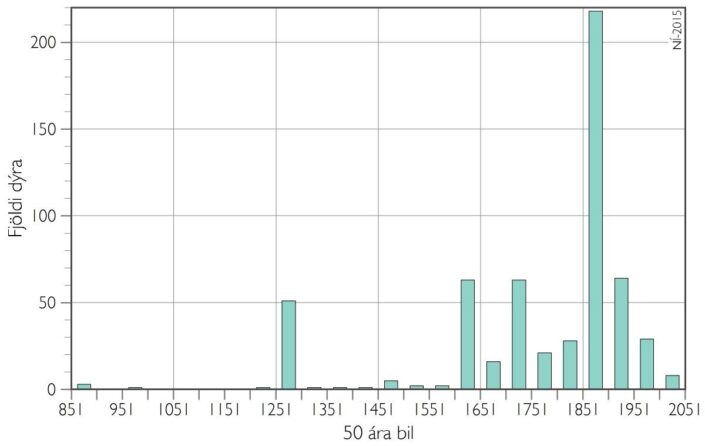Theglobal abundance of the polar bear (Ursus maritimus) is estimated at about 26,000 individuals, and according to the IUCN (International Union for Conservation of Nature) Red List classification, the species is designated (most recently in 2015) as “vulnerable,” i.e. in the group of species threatened with extinction, but nevertheless less threatened than those designated as endangered and critically endangered.
On September 19, a polar bear was spotted on Iceland’s West Fjords peninsula. In all likelihood, it had arrived on an iceberg from nearby Greenland. Unfortunately, according to Icelandic procedures, the animal was shot.
Polar bear spotted in the West Fjords
Information about the sighting of a bear roaming among buildings on the coast of the Jökulfirðir fjord in the northern part of the West Fjords was given to police and the Coast Guard by the owner of a nearby vacation home. Jökulfirðir lies north of the town of Ísafjörður and south of the coast of the Hornstrandir Nature Reserve.
These are some of the most sparsely inhabited areas of Iceland, so it is not out of the question that the animal has been in the area for a bit longer. In recent days, an increased number of icebergs have been observed in the waters surrounding the West Fjords, some of which were unusually large. According to eyewitness accounts, they could reach up to 30 meters in height. It is on such icebergs that polar bears reach Iceland.
Icelandic police shoot polar bear
Unfortunately, polar bears that get carried away by the winding and reach Iceland do not have a good end in sight. In 2008, after another white bear visit to Iceland, the Icelandic Minister of the Environment, set up a special working team to develop rules for the treatment of polar bears reaching Iceland. The team was composed of specialists and representatives from the Ministry of the Environment, the Icelandic Environmental Agency, the Icelandic Institute of Natural History, the Icelandic Food and Veterinary Authority, and the Icelandic Police and Coast Guard.
Unfortunately, according to the study by this team, polar bears that reach Iceland should be shot. This is what happened on September 20, 2024 with the aforementioned bear spotted on the coast of Jökulfirðir. The reasons why Iceland has adopted such a ruthless policy towards polar bears are several. First of all, the Icelandic environment does not provide polar bears with natural conditions for survival [source: ni.is]. There is neither enough ice and seals for them to hunt (on average, a polar bear needs more than 40 seals to survive a year [source: Gdansk Zoo]), nor good conditions for reproduction. So it is also impossible to create a convenient natural reserve for them. Left to its own devices, the bear would be doomed to a slow death by starvation, or it would have to find and plunder human garbage cans. In the autumn it could try to hunt sheep, but it would probably not survive the winter. Trapping and taking the animal back to Greenland would not only be very expensive, it is also forbidden by Greenlandic (and Danish) law. On the one hand, this is to defend the local population from potential disease contamination from other countries. On the other hand, it is the result of the fact that, according to a study by Greenlandic scientists, the polar bear population in eastern Greenland is doing so well that the disappearance of individual bears poses no threat to it.
Theglobal abundance of the polar bear (Ursus maritimus) is estimated at about 26,000 individuals, and according to the IUCN (International Union for Conservation of Nature) Red List classification, the species is designated (most recently in 2015) as “vulnerable,” i.e. in the group of species threatened with extinction, but nevertheless less threatened than those designated as endangered and critically endangered.
Taking all these considerations into account, a rule was adopted in 2008 to cull bears that reach Iceland.
And this is what happened to the bear that arrived in Iceland in the last days, in September 2024. After consulting with the Ministry of the Environment, snipers of the local police shot the animal, and the Coast Guard transported its body to the Natural History Institute.
Iceland’s first polar bear in 10 years
Polar bears are not natural inhabitants of Iceland. They do not have good conditions here either for hunting or breeding. However, favorable conditions for them are found in Greenland. And although the two countries are separated by 300 kilometers of the Denmark Strait, it happens that on crags and icebergs a lost polar bear makes its way from one land to the other. Polar bears naturally travel long distances in search of food. They often hunt seals on the edge of the Greenland ice sheet. When they “miss” a good time to return to the mainland, they drift with the ice floe or iceberg to the open ocean and, with a bit of “luck,” can end up in Iceland, for example. According to the Icelandic Institute of Natural History, a total of as many as 600 cases of such “visits” to Iceland by polar bears have been recorded in historical times. As recently as the second half of the 20th century, this happened at least once every 2 years, in the first half of the 20th century at least once a year, and by the end of the 19th century an average of more than 4 times a year!“
In the current century, Iceland has been “visited” by only 6 bears: in 2008 (two animals), 2010, 2011, 2016 and the latter – in 2024. So it’s clear that the number of animals reaching Iceland is declining, even though it’s likely that it was in the old days that there was a greater chance that a bear reached Iceland but was not spotted, or that it was spotted but not recorded anywhere [photo in article header: Gdansk Zoo;photos in article: West Fjords Police(Lögreglan á Vestfjörðum)]
